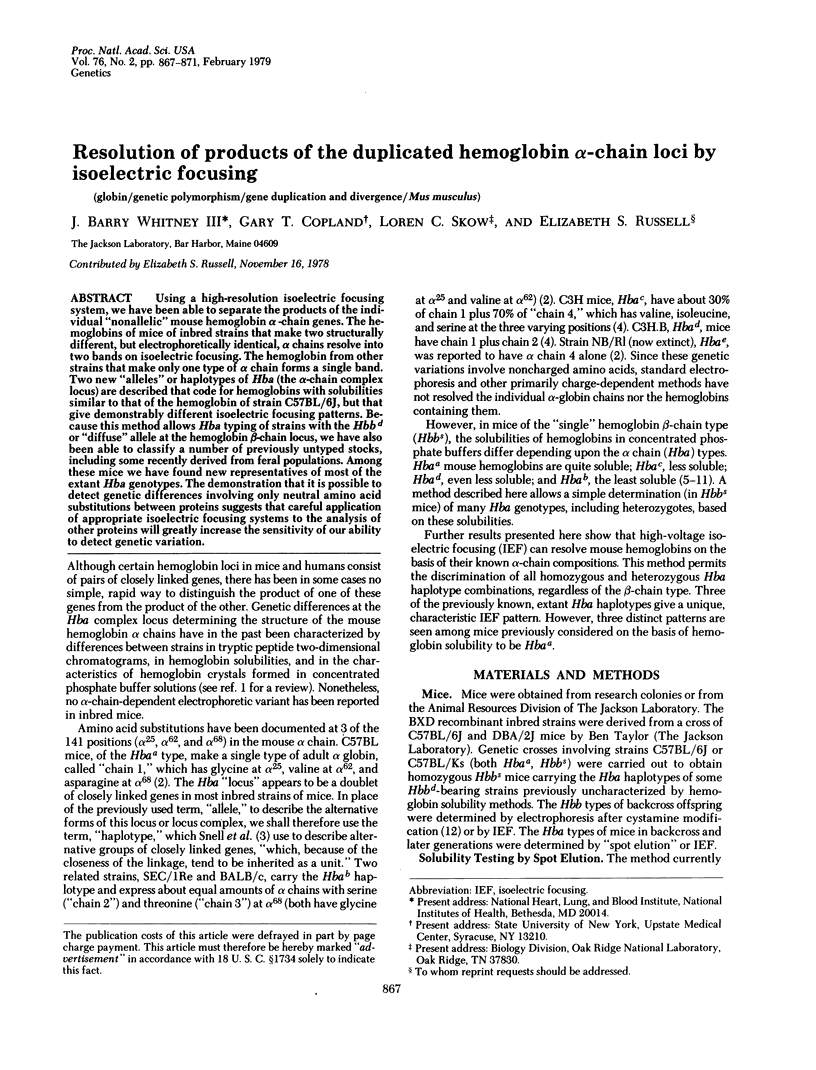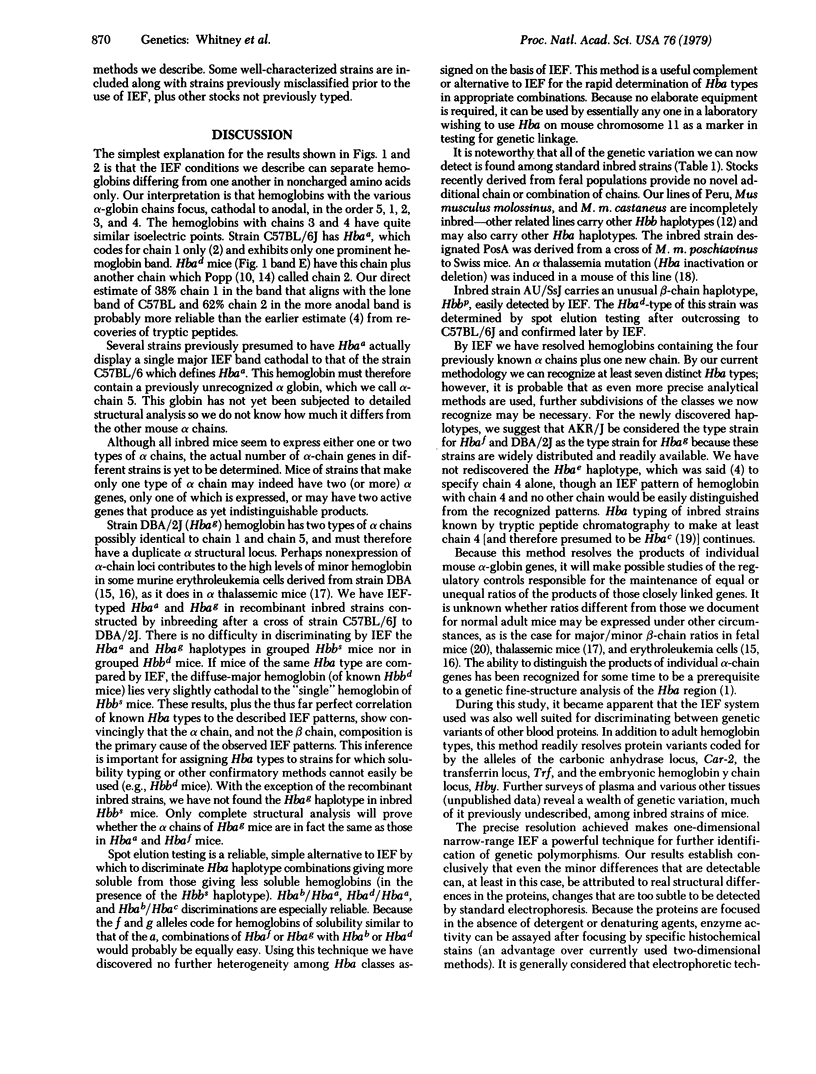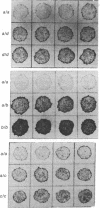Abstract
Using a high-resolution isoelectric focusing system, we have been able to separate the products of the individual "nonallelic+ mouse hemoglobin alpha-chain genes. The hemoglobins of mice of inbred strains that make two structurally different, but electrophoretically identical, alpha chains resolve into two bands on isoelectric focusing. The hemoglobin from other strains that make only one type of alpha chain forms a single band. Two new "alleles" of haplotypes of Hba (the alpha-chain complex locus) are described that code for hemoglobins with solubilities similar to that of the hemoglobin of strain C57BL/6J, but that give demonstrably different isoelectric focusing patterns. Because this method allows Hba typing of strains with the Hbbd or "diffuse" allele at the hemoglobin beta-chain locus, we have also been able to classify a number of previously untyped stocks, including some recently derived from feral populations. Among these mice we have found new representatives of most of the extant Hba genotypes. The demonstration that it is possible to detect genetic differences involving only neutral amino acid substitutions between proteins suggest that careful application of appropriate isoelectric focusing systems to the analysis of other proteins will greatly increase the sensitivity of our ability to detect genetic variation.
Full text
PDF




Images in this article
Selected References
These references are in PubMed. This may not be the complete list of references from this article.
- HUTTON J. J., SCHWEET R. S., WOLFE H. G., RUSSELL E. S. HEMOGLOBIN SOLUBILITY AND ALPHA-CHAIN STRUCTURE IN CROSSES BETWEEN TWO INBREAD MOUSE STRAINS. Science. 1964 Jan 17;143(3603):252–253. doi: 10.1126/science.143.3603.252. [DOI] [PubMed] [Google Scholar]
- Hilse K., Popp R. A. Gene duplication as the basis for amino acid ambiguity in the alpha-chain polypeptides of mouse hemoglobins. Proc Natl Acad Sci U S A. 1968 Nov;61(3):930–936. doi: 10.1073/pnas.61.3.930. [DOI] [PMC free article] [PubMed] [Google Scholar]
- Hutton J. J. Linkage analyses using biochemical variants in mice. I. Linkage of the hemoglobin beta-chain and glucosephosphate isomerase loci. Biochem Genet. 1969 Oct;3(5):507–515. doi: 10.1007/BF00485611. [DOI] [PubMed] [Google Scholar]
- Kabat D., Sherton C. C., Evans L. H., Bigley R., Koler R. D. Synthesis of erythrocyte-specific proteins in cultured friend leukemia cells. Cell. 1975 Jul;5(3):331–338. doi: 10.1016/0092-8674(75)90109-9. [DOI] [PubMed] [Google Scholar]
- Nudel U., Salmon J., Fibach E., Terada M., Rifkind R., Marks P. A., Bank A. Accumulation of alpha- and beta-globin messenger RNAs in mouse erythroleukemia cells. Cell. 1977 Oct;12(2):463–469. doi: 10.1016/0092-8674(77)90122-2. [DOI] [PubMed] [Google Scholar]
- POPP R. A. Hemoglobin loci: mice classified for their Hb and Sol alleles. Science. 1963 May 24;140(3569):893–894. doi: 10.1126/science.140.3569.893. [DOI] [PubMed] [Google Scholar]
- Popp R. A. Hemoglobins of mice: sequence and possible ambiguity at one position of the alpha chain. J Mol Biol. 1967 Jul 14;27(1):9–16. doi: 10.1016/0022-2836(67)90347-6. [DOI] [PubMed] [Google Scholar]
- Popp R. A. Studies on the mouse hemoglobin loci. IX. A fifth alpha-chain phenotype. J Hered. 1969 May-Jun;60(3):128–131. [PubMed] [Google Scholar]
- Popp R. A. Studies on the mouse hemoglobin loci. X. Linkage of duplicate genes at the alpha-chain locus, Hba. J Hered. 1969 May-Jun;60(3):131–133. [PubMed] [Google Scholar]
- Russell E. S., Blake S. L., McFarland E. C. Characterization and strain distribution of four alleles at the hemoglobin -chain structural locus in the mouse. Biochem Genet. 1972 Dec;7(3):313–330. doi: 10.1007/BF00484831. [DOI] [PubMed] [Google Scholar]
- Russell E. S., McFarland E. C. Genetics of mouse hemoglobins. Ann N Y Acad Sci. 1974 Nov 29;241(0):25–38. doi: 10.1111/j.1749-6632.1974.tb21864.x. [DOI] [PubMed] [Google Scholar]
- WOLFE H. G., RUSSELL E. S., PACKER S. O. HEMOGLOBINS IN MICE. SEGREGATION OF GENETIC FACTORS AFFECTING ELECTROPHORETIC MOBILITY AND SOLUBILITY. J Hered. 1963 May-Jun;54:107–112. doi: 10.1093/oxfordjournals.jhered.a107236. [DOI] [PubMed] [Google Scholar]
- Whitney J. B., 3rd Differential control of the synthesis of two hemoglobin beta chains in normal mice. Cell. 1977 Dec;12(4):863–871. doi: 10.1016/0092-8674(77)90150-7. [DOI] [PubMed] [Google Scholar]
- Whitney J. B., 3rd Simplified typing of mouse hemoglobin (Hbb) phenotypes using cystamine. Biochem Genet. 1978 Aug;16(7-8):667–672. doi: 10.1007/BF00484723. [DOI] [PubMed] [Google Scholar]





